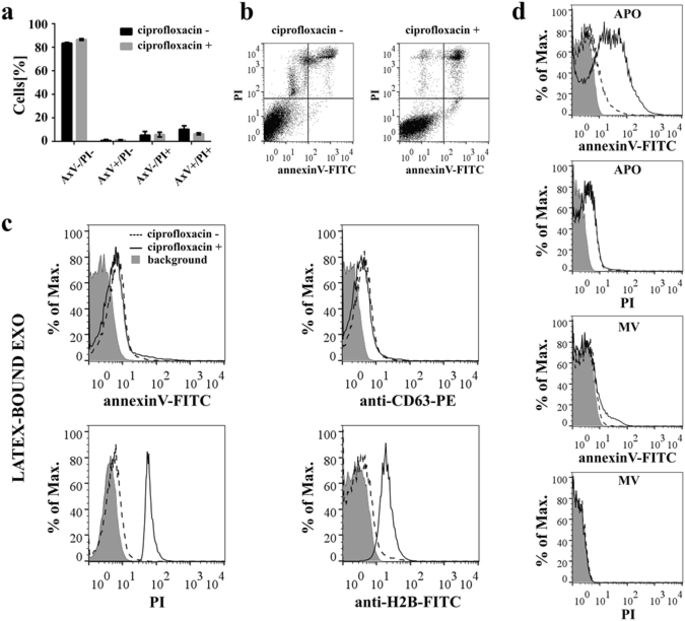Our official English website, www.x-mol.net, welcomes your
feedback! (Note: you will need to create a separate account there.)
Antibiotic-induced release of small extracellular vesicles (exosomes) with surface-associated DNA.
Scientific Reports ( IF 3.8 ) Pub Date : 2017-Aug-15 , DOI: 10.1038/s41598-017-08392-1 Andrea Németh , Norbert Orgovan , Barbara W Sódar , Xabier Osteikoetxea , Krisztina Pálóczi , Katalin É. Szabó-Taylor , Krisztina V. Vukman , Ágnes Kittel , Lilla Turiák , Zoltán Wiener , Sára Tóth , László Drahos , Károly Vékey , Robert Horvath , Edit I. Buzás
Scientific Reports ( IF 3.8 ) Pub Date : 2017-Aug-15 , DOI: 10.1038/s41598-017-08392-1 Andrea Németh , Norbert Orgovan , Barbara W Sódar , Xabier Osteikoetxea , Krisztina Pálóczi , Katalin É. Szabó-Taylor , Krisztina V. Vukman , Ágnes Kittel , Lilla Turiák , Zoltán Wiener , Sára Tóth , László Drahos , Károly Vékey , Robert Horvath , Edit I. Buzás

|
Recently, biological roles of extracellular vesicles (which include among others exosomes, microvesicles and apoptotic bodies) have attracted substantial attention in various fields of biomedicine. Here we investigated the impact of sustained exposure of cells to the fluoroquinolone antibiotic ciprofloxacin on the released extracellular vesicles. Ciprofloxacin is widely used in humans against bacterial infections as well as in cell cultures against Mycoplasma contamination. However, ciprofloxacin is an inducer of oxidative stress and mitochondrial dysfunction of mammalian cells. Unexpectedly, here we found that ciprofloxacin induced the release of both DNA (mitochondrial and chromosomal sequences) and DNA-binding proteins on the exofacial surfaces of small extracellular vesicles referred to in this paper as exosomes. Furthermore, a label-free optical biosensor analysis revealed DNA-dependent binding of exosomes to fibronectin. DNA release on the surface of exosomes was not affected any further by cellular activation or apoptosis induction. Our results reveal for the first time that prolonged low-dose ciprofloxacin exposure leads to the release of DNA associated with the external surface of exosomes.
中文翻译:

抗生素诱导的与表面相关的DNA释放小细胞外囊泡(外泌体)。
近来,细胞外囊泡(包括外泌体,微囊泡和凋亡小体)的生物学作用已在生物医学的各个领域引起了广泛的关注。在这里,我们研究了细胞持续暴露于氟喹诺酮类抗生素环丙沙星对释放的细胞外囊泡的影响。环丙沙星被广泛用于人类抵抗细菌感染以及细胞培养以预防支原体污染。但是,环丙沙星是哺乳动物细胞氧化应激和线粒体功能障碍的诱因。出乎意料的是,在这里我们发现环丙沙星诱导了在本文称为外泌体的小细胞外囊泡的面外表面上的DNA(线粒体和染色体序列)和DNA结合蛋白的释放。此外,无标记的光学生物传感器分析显示外泌体与纤连蛋白的DNA依赖性结合。外泌体表面上的DNA释放不再受到细胞激活或凋亡诱导的进一步影响。我们的结果首次揭示了长时间低剂量环丙沙星暴露会导致与外泌体外表面相关的DNA释放。
更新日期:2017-08-15
中文翻译:

抗生素诱导的与表面相关的DNA释放小细胞外囊泡(外泌体)。
近来,细胞外囊泡(包括外泌体,微囊泡和凋亡小体)的生物学作用已在生物医学的各个领域引起了广泛的关注。在这里,我们研究了细胞持续暴露于氟喹诺酮类抗生素环丙沙星对释放的细胞外囊泡的影响。环丙沙星被广泛用于人类抵抗细菌感染以及细胞培养以预防支原体污染。但是,环丙沙星是哺乳动物细胞氧化应激和线粒体功能障碍的诱因。出乎意料的是,在这里我们发现环丙沙星诱导了在本文称为外泌体的小细胞外囊泡的面外表面上的DNA(线粒体和染色体序列)和DNA结合蛋白的释放。此外,无标记的光学生物传感器分析显示外泌体与纤连蛋白的DNA依赖性结合。外泌体表面上的DNA释放不再受到细胞激活或凋亡诱导的进一步影响。我们的结果首次揭示了长时间低剂量环丙沙星暴露会导致与外泌体外表面相关的DNA释放。































 京公网安备 11010802027423号
京公网安备 11010802027423号